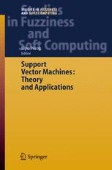Search
Search Results
-
Evolution of the Internet Topology and Traffic Dynamics of Data Packets
In recent years, the Internet has become one of the most influential media in our daily life, going beyond in its role as the basic infrastructure in...
-
Iterative Single Data Algorithm for Training Kernel Machines from Huge Data Sets: Theory and Performance
The chapter introduces the latest developments and results of Iterative Single Data Algorithm (ISDA) for solving large-scale support vector machines...
-
Application of Support Vector Machines in Inverse Problems in Ocean Color Remote Sensing
Neural networks are widely used as transfer functions in inverse problems in remote sensing. However, this method still suffers from some problems...
-
Tachycardia Discrimination in Implantable Cardioverter Defibrillators Using Support Vector Machines and Bootstrap Resampling
Accurate automatic discrimination between supraventricular (SV) and ventricular (V) tachycardia (T) in implantable cardioverter defibrillators (ICD)...
-
Cancer Diagnosis and Protein Secondary Structure Prediction Using Support Vector Machines
In this chapter, we use support vector machines (SVMs) to deal with two bioinformatics problems, i.e., cancer diagnosis based on gene expression data...
-
The Kernel Memory Concept – A Paradigm Shift from Conventional Connectionism
In this chapter, the general concept of kernel memory (KM) is described, which is given as the basis for not only representing the general notion of...
-
Modelling Abstract Notions Relevant to the Mind and the Associated Modules
This chapter is devoted to the remaining four modules within the AMS, i.e. 1) attention, 2) emotion, 3) intention, and 4) intuition module, and their...
-
INTELLIGENT MUSICAL INSTRUMENT SOUND CLASSIFICATION
This chapter is devoted to intelligent classification of the sound of musical instruments. Although it is possible, and in some applications...
-
INTRODUCTION
Over the last decade, a series of publications has brought and established new research areas related to music, and intensified the research verging...
-
Synchronization in Complex Networks
The study of complex systems pervades all of science, from cell biology to ecology, from computer science to meteorology. A paradigm of a complex...
-
Data Traffic, Topology and Congestion
We consider the interaction between the topology of a network and the tra.c carried along its channels. The binding elements between the topology and...
-
Kernel Discriminant Learning with Application to Face Recognition
When applied to high-dimensional pattern classification tasks such as face recognition, traditional kernel discriminant analysis methods often suffer...
-
Multiple Model Estimation for Nonlinear Classification
This chapter describes a new method for nonlinear classification using a collection of several simple (linear) classifiers. The approach is based on...
-
Active Support Vector Learning with Statistical Queries
The article describes an active learning strategy to solve the large quadratic programming (QP) problem of support vector machine (SVM) design in...
-
Introduction
Genetic algorithms (GAs) are powerful search techniques based on principles of evolution. They are now widely applied to solve problems in many...
-
Linkage Learning Genetic Algorithm
In order to handle linkage evolution and to tackle the ordering problem, Harik [47] took Holland’s call [53] for the evolution of tight linkage quite...
-
Preliminaries: Assumptions and the Test Problem
After introducing the background and motivation of the linkage learning genetic algorithm, we will start to improve and understand the linkage...
-
Clustering Via Decision Tree Construction
Clustering is an exploratory data analysis task. It aims to find the intrinsic structure of data by organizing data objects into similarity groups or...
-
A New Theoretical Framework for K-Means-Type Clustering
One of the fundamental clustering problems is to assign n points into k clusters based on the minimal sum-of-squares(MSSC), which is known to be...
-
PERCEPTUAL BASES OF HEARING AND MUSIC PERCEPTION
The human auditory system pertains to the entire peripheral auditory mechanism. Classically, the peripheral auditory system has been divided into...
